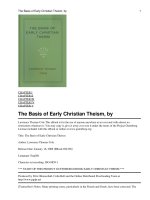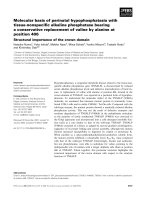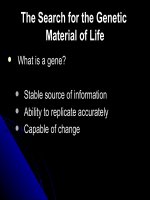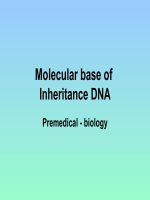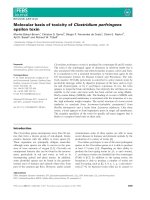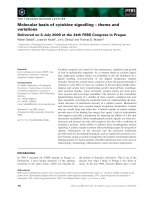Molecular basis of heredity
Bạn đang xem bản rút gọn của tài liệu. Xem và tải ngay bản đầy đủ của tài liệu tại đây (1.58 MB, 21 trang )
The Search for the Genetic
Material of Life
What is a gene?
Stable source of information
Ability to replicate accurately
Capable of change
The Search for the Molecular Basis of Heredity
The Search for the Molecular Basis of Heredity
Search for genetic material nucleic acid or protein/DNA
Search for genetic material nucleic acid or protein/DNA
or RNA?
or RNA?
Griffith’s Transformation Experiment
Griffith’s Transformation Experiment
Avery’s Transformation Experiment
Avery’s Transformation Experiment
Hershey-Chase Bacteriophage Experiment
Hershey-Chase Bacteriophage Experiment
Tobacco Mosaic Virus (TMV) Experiment
Tobacco Mosaic Virus (TMV) Experiment
Nucleotides - composition and structure
Nucleotides - composition and structure
Double-helix model of DNA - Watson & Crick
Double-helix model of DNA - Watson & Crick
Original Source for portions of slide content:
Original Source for portions of slide content:
/> /> by
by
Kevin McCracken University of Alaska Fairbanks.
Kevin McCracken University of Alaska Fairbanks.
Timeline of events
1890 Weismann - substance in the cell nuclei controls
development.
1900 Chromosomes shown to contain hereditary
information, later shown to be composed of protein &
nucleic acids.
1928 Griffith’s Transformation Experiment
1944 Avery’s Transformation Experiment
1953 Hershey-Chase Bacteriophage Experiment
1953 Watson & Crick propose double-helix model of DNA
1956 Gierer & Schramm/Fraenkel-Conrat & Singer
Demonstrate RNA is viral genetic material.
Frederick Griffith’s Transformation Experiment - 1928
“transforming principle” demonstrated with Streptococcus pneumoniae
Griffith hypothesized that the transforming agent was a “IIIS” protein.
Peter J. Russell, iGenetics: Copyright © Pearson Education, Inc., publishing as Benjamin Cummings.
Oswald T. Avery’s Transformation Experiment -
1944
Determined that “IIIS” DNA was the genetic material
responsible for Griffith’s results (not RNA).
Bacteriophage =
Virus that
attacks bacteria
and replicates
by invading a
living cell and
using the cell’s
molecular
machinery.
Structure of T2
phage
DNA & protein
Hershey-Chase Bacteriophage Experiment - 1953
Life cycle of virulent T2 phage:
1. T2 bacteriophage is
composed of DNA and
proteins:
2. Set-up two replicates:
•
Label DNA with
32
P
•
Label Protein with
35
S
3. Infected E. coli bacteria with
two types of labeled T2
4.
32
P is discovered within the
bacteria and progeny
phages, whereas
35
S is not
found within the bacteria but
released with phage ghosts.
Hershey-Chase Bacteriophage Experiment - 1953
1969: Alfred Hershey
Gierer & Schramm Tobacco Mosaic Virus (TMV) Experiment –
1956 & Fraenkel-Conrat & Singer - 1957
•
Used 2 viral strains to demonstrate RNA is the genetic material of TMV
Conclusions about these early
experiments:
•
Griffith 1928 & Avery 1944:
•
DNA (not RNA) is transforming agent.
•
Hershey-Chase 1953:
•
DNA (not protein) is the genetic material.
•
Gierer & Schramm 1956/Fraenkel-Conrat &
Singer 1957:
•
RNA (not protein) is genetic material of
some viruses.
Nucleotide = monomers that make up DNA and RNA (Figs. 2.9-10)
Three components
1. Pentose (5-carbon) sugar
DNA = deoxyribose
RNA = ribose
(compare 2’ carbons)
2. Nitrogenous base
Purines
Adenine
Guanine
Pyrimidines
Cytosine
Thymine (DNA)
Uracil (RNA)
3. Phosphate group attached to 5’ carbon
Nucleotides are linked by phosphodiester bonds
to form polynucleotides.
Phosphodiester bond
Covalent bond between the phosphate group (attached to
5’ carbon) of one nucleotide and the 3’ carbon of the
sugar of another nucleotide.
This bond is very strong, and for this reason DNA is
remarkably stable. DNA can be boiled and even
autoclaved without degrading!
5’ and 3’
The ends of the DNA or RNA chain are not the same. One
end of the chain has a 5’ carbon and the other end has a
3’ carbon.
5’ end
3’ end
James D. Watson & Francis H. Crick - 1953
Double Helix Model of DNA
Two sources of information:
1. Base composition studies of Erwin Chargaff
•
indicated double-stranded DNA consists of ~50% purines
(A,G) and ~50% pyrimidines (T, C)
•
amount of A = amount of T and amount of G = amount of C
(Chargraff’s rules)
•
%GC content varies from organism to organism
Examples: %A %T %G %C %GC
Homo sapiens 31.0 31.5 19.1 18.4 37.5
Zea mays 25.6 25.3 24.5 24.6 49.1
Drosophila 27.3 27.6 22.5 22.5 45.0
Aythya americana 25.8 25.8 24.2 24.2 48.4
James D. Watson & Francis H. Crick - 1953
Double Helix Model of DNA
Two sources of information:
2. X-ray diffraction studies - Rosalind Franklin & Maurice Wilkins
Conclusion-DNA is a helical structure with
distinctive regularities, 0.34 nm & 3.4 nm.
Double Helix Model of DNA: Six main features
1. Two polynucleotide chains wound in a right-handed (clockwise)
double-helix.
2. Nucleotide chains are anti-parallel: 5’ → 3’
3’ ← 5’
3. Sugar-phosphate backbones are on the outside of the double
helix, and the bases are oriented towards the central axis.
4. Complementary base pairs from opposite strands are bound
together by weak hydrogen bonds.
A pairs with T (2 H-bonds), and G pairs with C (3 H-bonds).
e.g., 5’-TATTCCGA-3’
3’-ATAAGGCT-3’
5. Base pairs are 0.34 nm apart. One complete turn of the helix
requires 3.4 nm (10 bases/turn).
6. Sugar-phosphate backbones are not equally-spaced, resulting in
major and minor grooves.
1962: Nobel Prize in Physiology and Medicine
James D.
Watson
Francis H.
Crick
Maurice H. F.
Wilkins
What about?
Rosalind Franklin
Yeast Alanine tRNA
RNA (A pairs with U and C pairs with G)
Examples:
mRNA messenger RNA
tRNA transfer RNA
rRNA ribosomal RNA
snRNA small nuclear RNA
RNA secondary structure:
single-stranded
Function in
transcription
(RNA processing)
and translation
Organization of DNA/RNA in chromosomes
Genome = chromosome or set of chromosomes that contains all the
DNA an organism (or organelle) possesses
Prokaryotic chromosomes
1. most contain one double-stranded circular
DNA molecule
2. typically arranged in arranged in a dense
clump in a region called the nucleoid
Eukaryotic chromosomes
1. Eukaryotic chromosome structure
Chromatin - complex of DNA and chomosomal
proteins ~ twice as much or more protein as
DNA.
2. Eukaryotic chromosomes or chromatin found in the
nucleus of the cell.
3. Cells from different species contain varying numbers
of chromosome of different sizes
and morphologies -the karyotype (e.g., pea, 2N =
14; human, 2N = 46, fruit fly, 2N= 8).


